Synthesis, Structures, and Water Adsorption of Two Coordination Polymers Constructed by M(II) (M = Ni (1) and Zn (2)) with 1,3-Bis(4-Pyridyl)Propane (bpp) and 1,2,4,5-Benzenetetracarboxylate (BT4−) Ligands
Abstract
1. Introduction
2. Experimental Details
2.1. General Procedures
2.2. Synthesis of {[Ni2(bpp)2(BT)(H2O)6] 1.5(EtOH) 1.5H2O}n (1)
2.3. Synthesis of [Zn(bpp)(BT)0.5]·5H2O (2)
2.4. X-ray Crystallography and Refinements
2.5. In Situ X-ray Powder Diffraction
3. Results and Discussion
3.1. Synthesis and IR Spectroscopy
3.2. Structural Characterization of {[Ni2(bpp)2(BT)(H2O)6] 1.5(EtOH)·1.5H2O}n (1)
3.3. Structural Description of {[Zn(bpp)(BT)0.5]·5H2O}n (2)
3.4. Water De-/Adsorption Behaviors of CPs 1 and 2 by Cyclic TG Analysis
3.5. Water Sorption Studies of CP 1
4. Conclusions
Supplementary Materials
Author Contributions
Funding
Acknowledgments
Conflicts of Interest
References
- Batten, S.R.; Champness, N.R.; Chen, X.-M.; Garcia-Martinez, J.; Kitagawa, S.; Öhrström, L.; O’Keeffe, M.; Suh, M.P.; Reedijk, J. Coordination polymers, metal–organic frameworks and the need for terminology guidelines. CrystEngComm 2012, 14, 3001–3004. [Google Scholar] [CrossRef]
- Terminology of Metal-Organic Frameworks and Coordination Polymers. Chem. Int. 2013, 35, 1715–1724. [CrossRef]
- Li, B.; Chrzanowski, M.; Zhang, Y.; Ma, S. Applications of metal-organic frameworks featuring multi-functional sites. Coord. Chem. Rev. 2016, 307, 106–129. [Google Scholar] [CrossRef]
- Zhang, X.; Wang, W.; Hu, Z.; Wang, G.; Uvdal, K. Coordination polymers for energy transfer: Preparations, properties, sensing applications, and perspectives. Coord. Chem. Rev. 2015, 284, 206–235. [Google Scholar] [CrossRef]
- Bradshaw, D.; Claridge, J.B.; Cussen, E.J.; Prior, T.J.; Rosseinsky, M.J. Design, Chirality, and Flexibility in Nanoporous Molecule-Based Materials. Acc. Chem. Res. 2015, 38, 273–282. [Google Scholar] [CrossRef]
- Silva, P.; Vilela, S.M.F.; Tome, J.P.C.; Paz, F.A.A. Multifunctional metal–organic frameworks: From academia to industrial applications. Chem. Soc. Rev. 2015, 44, 6774–6803. [Google Scholar] [CrossRef]
- Li, S.; Huo, F. Metal–organic framework composites: From fundamentals to applications. Nanoscale 2015, 7, 7482–7501. [Google Scholar] [CrossRef]
- Janiak, C.; Vieth, J.K. MOFs, MILs and more: Concepts, properties and applications for porous coordination networks (PCNs). New J. Chem. 2010, 34, 2366. [Google Scholar] [CrossRef]
- He, Y.; Li, B.; O’Keeffe, M.; Chen, B. Multifunctional metal–organic frameworks constructed from meta-benzenedicarboxylate units. Chem. Soc. Rev. 2014, 43, 5618–5656. [Google Scholar] [CrossRef]
- Lin, Z.-J.; Lu, J.; Hong, M.; Cao, R. Metal–organic frameworks based on flexible ligands (FL-MOFs): Structures and applications. Chem. Soc. Rev. 2014, 43, 5867–5895. [Google Scholar] [CrossRef]
- Jia, H.P.; Li, W.; Ju, Z.F.; Zhang, J. Co5(μ3-OH)2(btec)2(bpp)]n: A three-dimensional homometallic molecular metamagnet built from the mixed hydroxide/carboxylate-bridged ferromagnetic-like chains. Dalton Trans. 2007, 33, 3699–3704. [Google Scholar] [CrossRef] [PubMed]
- Yang, E.-C.; Liu, Z.-Y.; Liu, T.-Y.; Li, L.-L.; Zhao, X.-J. Co-ligand-directed structural and magnetic diversities in an anisotropic CoII–triazolate system. Dalton Trans. 2011, 40, 8132. [Google Scholar] [CrossRef] [PubMed]
- Zhao, L.M.; Li, H.H.; Wu, Y.; Zhang, S.Y.; Zhang, Z.J.; Shi, W.; Cheng, P.; Liao, D.Z.; Yan, S.P. Synthesis, crystal structures, and magnetic properties of Mn(II), Co(II), and Zn(II) coordination polymers containing 1,2,4,5-benzenetetracarboxylic acid and 4,4′-azobispyridine. Eur. J. Inorg. Chem. 2010, 13, 1983–1990. [Google Scholar] [CrossRef]
- Fabelo, O.; Canñadillas-Delgado, L.; Pasaán, J.; Delgado, F.S.; Lloret, F.; Cano, J.; Julve, M.; Ruiz-Pérez, C. Study of the Influence of the Bridge on the Magnetic Coupling in Cobalt(II) Complexes. Inorg. Chem. 2009, 48, 11342–11351. [Google Scholar] [CrossRef] [PubMed]
- Fabelo, O.; Pasán, J.; Cañadillas-Delgado, L.; Delgado, F.S.; Yuste, C.; Lloret, F.; Julve, M.; Ruiz-Pérez, C. Novel cobalt(II) coordination polymers based on 1,2,4,5-benzenetetracarboxylic acid and extended bis-monodentate ligands. CrystEngComm 2009, 11, 2169. [Google Scholar] [CrossRef]
- Cheng, D.; Khan, M.A.; Houser, R.P. Novel Sandwich Coordination Polymers Composed of Cobalt(II), 1,2,4,5-Benzenetetracarboxylato Ligands, and Homopiperazonium Cations. Cryst. Growth Des. 2002, 2, 415–420. [Google Scholar] [CrossRef]
- Sun, D.; Zhang, N.; Luo, G.; Xu, Q.-J.; Huang, R.-B.; Zheng, L.-S. Assembly of silver(I) coordination polymers incorporating pyromellitic acid and N-heterocyclic ligands. Polyhedron 2010, 29, 1842–1848. [Google Scholar] [CrossRef]
- Ren, C.; Hou, L.; Liu, B.; Yang, G.; Wang, Y.-Y.; Shi, Q.-Z. Distinct structures of coordination polymers incorporating flexible triazole-based ligand: Topological diversities, crystal structures and property studies. Dalton Trans. 2011, 40, 793–804. [Google Scholar] [CrossRef]
- Luo, G.; Wu, S.-H.; Zhao, Q.-H.; Li, D.; Xiao, Z.-J.; Dai, J.-C. Water helicate (H2O)5 hosted by a novel 2D CoII-coordination framework with left- and right-handed helical units. Inorg. Chem. Commun. 2012, 20, 290–294. [Google Scholar] [CrossRef]
- Correa, C.C.; Diniz, R.; Janczak, J.; Yoshida, M.I.; De Oliveira, L.F.; Machado, F.C. High dimensional coordination polymers based on transition metals, 1,2,4,5-benzenetetracarboxylate anion and 1,3-bis(4-pyridyl)propane nitrogen ligand. Polyhedron 2010, 29, 3125–3131. [Google Scholar] [CrossRef]
- Atria, A.M.; Corsini, G.; Garland, M.T.; Baggio, R. Poly[4,40-(propane-1,3-diyl)dipyridinium bis{tetraaquabis(μ2-5-carboxybenzene-1,2,4-tricarboxylato)bis[μ2-1,3-bis(4-pyridyl)propane]dicobalt(II)}pentahydrate]. Acta Cryst. 2011, 67, m367–m370. [Google Scholar]
- Jeremias, F.; Khutia, A.; Janiak, C.; Henninger, S.K. MIL-100(Al, Fe) as water adsorbents for heat transformation purposes—A promising application. J. Mater. Chem. 2012, 22, 10148–10151. [Google Scholar] [CrossRef]
- Cañadillas-Delgado, L.; Fabelo, O.; Ruiz-Pérez, C.; Delgado, F.S.; Julve, M.; Hernandez-Molina, M.; Laz, M.M.; Lorenzo-Luis, P.A. Zeolite-like Nanoporous Gadolinium Complexes Incorporating Alkaline Cations. Cryst. Growth Des. 2006, 6, 87–93. [Google Scholar] [CrossRef]
- Majumder, A.; Gramlich, V.; Rosair, G.M.; Batten, S.R.; Masuda, J.D.; El Fallah, M.S.; Ribas, J.; Sutter, J.P.; Desplanches, C.; Mitra, S. Five New Cobalt(II) and Copper(II)-1,2,4,5-benzenetetracarboxylate Supramolecular Architectures: Syntheses, Structures, and Magnetic Properties. Cryst. Growth Des. 2006, 6, 2355–2368. [Google Scholar] [CrossRef]
- Li, Y.; Hao, N.; Lu, Y.; Wang, E.; Kang, Z.; Hu, C. New Two-Dimensional Metal−Organic Networks Constructed from 1,2,4,5-Benzenetetracarboxylate and Chelate Ligands. Inorg. Chem. 2003, 42, 3119–3124. [Google Scholar] [CrossRef]
- Fabelo, O.; Pasán, J.; Lloret, F.; Julve, M.; Ruiz-Pérez, C. 1,2,4,5-Benzenetetracarboxylate- and 2,2′-Bipyrimidine-Containing Cobalt(II) Coordination Polymers: Preparation, Crystal Structure, and Magnetic Properties. Inorg. Chem. 2008, 47, 3568–3576. [Google Scholar] [CrossRef]
- Halim, R.A.; Bhatt, P.M.; Belmabkhout, Y.; Shkurenko, A.; Adil, K.; Barbour, L.J.; Eddaoudi, M. A Fine-Tuned Metal–Organic Framework for Autonomous Indoor Moisture Control. J. Am. Chem. Soc. 2017, 139, 10715–10722. [Google Scholar] [CrossRef]
- Massoud, S.S.; Mautner, F.A.; Louka, F.R.; Demeshko, S.; Dechert, S.; Meyer, F. Diverse coordination of polynuclear copper(II) complexes constructed from benzene tetracarboxylates. Inorg. Chim. Acta 2011, 370, 435–443. [Google Scholar] [CrossRef]
- Mautner, F.A.; Albering, J.H.; Vicente, R.; Andrepont, C.; Gautreaux, J.G.; Gallo, A.A.; Massoud, S.S. Synthesis, structure and magnetic investigations of polycarboxylato-copper(II) complexes. Polyhedron 2013, 54, 158–163. [Google Scholar] [CrossRef]
- Li, X.-J.; Cao, R.; Bi, W.-H.; Wang, Y.-Q.; Wang, Y.; Li, X. Three interpenetrated frameworks constructed by long flexible N,N′-bipyridyl and dicarboxylate ligands. Polyhedron 2005, 24, 2955–2962. [Google Scholar] [CrossRef]
- Lee, T.-W.; Lau, J.P.-K.; Wong, W.-T. Synthesis and characterization of coordination polymers of Zn(II) with 1,3-bis(4-pyridyl)propane and 4,4′-pyridine ligands. Polyhedron 2004, 23, 999–1002. [Google Scholar] [CrossRef]
- Correa, C.C.; Diniz, R.; Chagas, L.H.; Rodrigues, B.L.; Yoshida, M.I.; Teles, W.M.; Machado, F.C.; De Oliveira, L.F.C. Transition metal complexes with squarate anion and the pyridyl-donor ligand 1,3-bis(4-pyridyl)propane (BPP): Synthesis, crystal structure and spectroscopic investigation. Polyhedron 2007, 26, 989–995. [Google Scholar] [CrossRef]
- Plater, M.J.; Foreman, M.R.S.; Gelbrich, T.; Hursthouse, M.B. One-dimensional structures of nickel(II) and cobalt(II) coordination complexes {[ML2(H2O)2]·L·H2O·(ClO4)2} (M = Co or Ni; L = 1,3-bis(4-pyridyl)propane) Inorg. Chim. Acta 2001, 318, 171–174. [Google Scholar]
- Maw-Cherng, S.; Chan, Z.K.; Chen, J.D.; Wang, J.C.; Hung, C.H. Syntheses and structures of three new coordination polymers generated from the flexible 1,3-bis(4-pyridyl)propane ligand and zinc salts. Polyhedron 2006, 25, 2325–2332. [Google Scholar]
- Carlucci, L.; Ciani, G.; Proserpio, D.M.; Rizzato, S. New polymeric networks from the self-assembly of silver(i) salts and the flexible ligand 1,3-bis(4-pyridyl)propane (bpp). A systematic investigation of the effects of the counterions and a survey of the coordination polymers based on bpp. CrystEngComm 2002, 4, 121–129. [Google Scholar] [CrossRef]
- Gao, E.-Q.; Xu, Y.-X.; Cheng, A.-L.; He, M.-Y.; Yan, C.-H. Copper(II) and cobalt(II) coordination polymers with azido ions and 1,3-bis(4′-pyridyl)propane. Inorg. Chem. Commun. 2006, 9, 212–215. [Google Scholar] [CrossRef]
- SMART V 4.043 Software for CCD Detector System; Siemens Analytical Instruments Division: Madison, WI, USA, 1995.
- SAINT V 4.035 Software for CCD Detector System; Siemens Analytical Instruments Division: Madison, WI, USA, 1995.
- Sheldrick, G.M. Program for the Refinement of Crystal Structures; University of Göttingen: Göttingen, Germany, 1993. [Google Scholar]
- SHELXTL 5.03 (PC-Version), Program Liberary for Structure Solution and Molecular Graphics; Siemens Analytical Instruments Division: Madison, WI, USA, 1995.
- Toby, B.H.; Von Dreele, R.B. GSAS-II: The genesis of a modern open-source all purpose crystallography software package. J. Appl. Crystallogr. 2013, 46, 544–549. [Google Scholar] [CrossRef]
- Yilmaz, G.; Peh, S.B.; Zhao, D.; Ho, G.W. Atomic- and Molecular-Level Design of Functional Metal–Organic Frameworks (MOFs) and Derivatives for Energy and Environmental Applications. Adv. Sci. 2019, 6. [Google Scholar] [CrossRef]
- Rieth, A.J.; Wright, A.M.; Skorupskii, G.; Mancuso, J.L.; Hendon, C.H.; Dincă, M. Diverse π–π stacking motifs modulate electrical conductivity in tetrathiafulvalene-based metal–organic frameworks. J. Am. Chem. Soc. 2019, 141, 13858–13866. [Google Scholar] [CrossRef]
- Furukawa, H.; Gándara, F.; Zhang, Y.-B.; Jiang, J.; Queen, W.L.; Hudson, M.R.; Yaghi, O.M. Water Adsorption in Porous Metal–Organic Frameworks and Related Materials. J. Am. Chem. Soc. 2014, 136, 4369–4381. [Google Scholar] [CrossRef]
- Wang, C.C.; Ke, S.Y.; Chen, K.T.; Sun, N.K.; Liu, W.F.; Ho, M.L.; Lu, B.J.; Hsieh, Y.T.; Lee, G.H.; Huang, S.Y.; et al. Sponge-Like Water De-/Ad-Sorption versus Solid-State Structural Transformation and Colour-Changing Behavior of an Entangled 3D Composite Supramolecuar Architecture, [Ni4(dpe)4(btc)2(Hbtc)(H2O)9]⋅3H2O. Polymers 2018, 10, 1014. [Google Scholar] [CrossRef] [PubMed]
- Ke, S.Y.; Chang, Y.F.; Wang, H.Y.; Yang, C.C.; Ni, C.W.; Lin, G.Y.; Chen, T.T.; Ho, M.L.; Lee, G.H.; Chuang, Y.C.; et al. Self-Assembly of Four Coordination Polymers (CPs) in A 3D Entangled Architecture Showing Reversible Dynamic Solid-State Structural Transformation and Color-Changing Behaviour by Thermal De-/Re-hydration. Cryst. Growth Des. 2014, 14, 4011–4018. [Google Scholar] [CrossRef]
- Fukushima, T.; Horike, S.; Inubushi, Y.; Nakagawa, K.; Kubota, Y.; Takata, M.; Kitagawa, S. Solid Solutions of Soft Porous Coordination Polymers: Fine-Tuning of Gas Adsorption Properties. Angw. Chem. Int. Ed. 2010, 49, 4820–4824. [Google Scholar] [CrossRef] [PubMed]

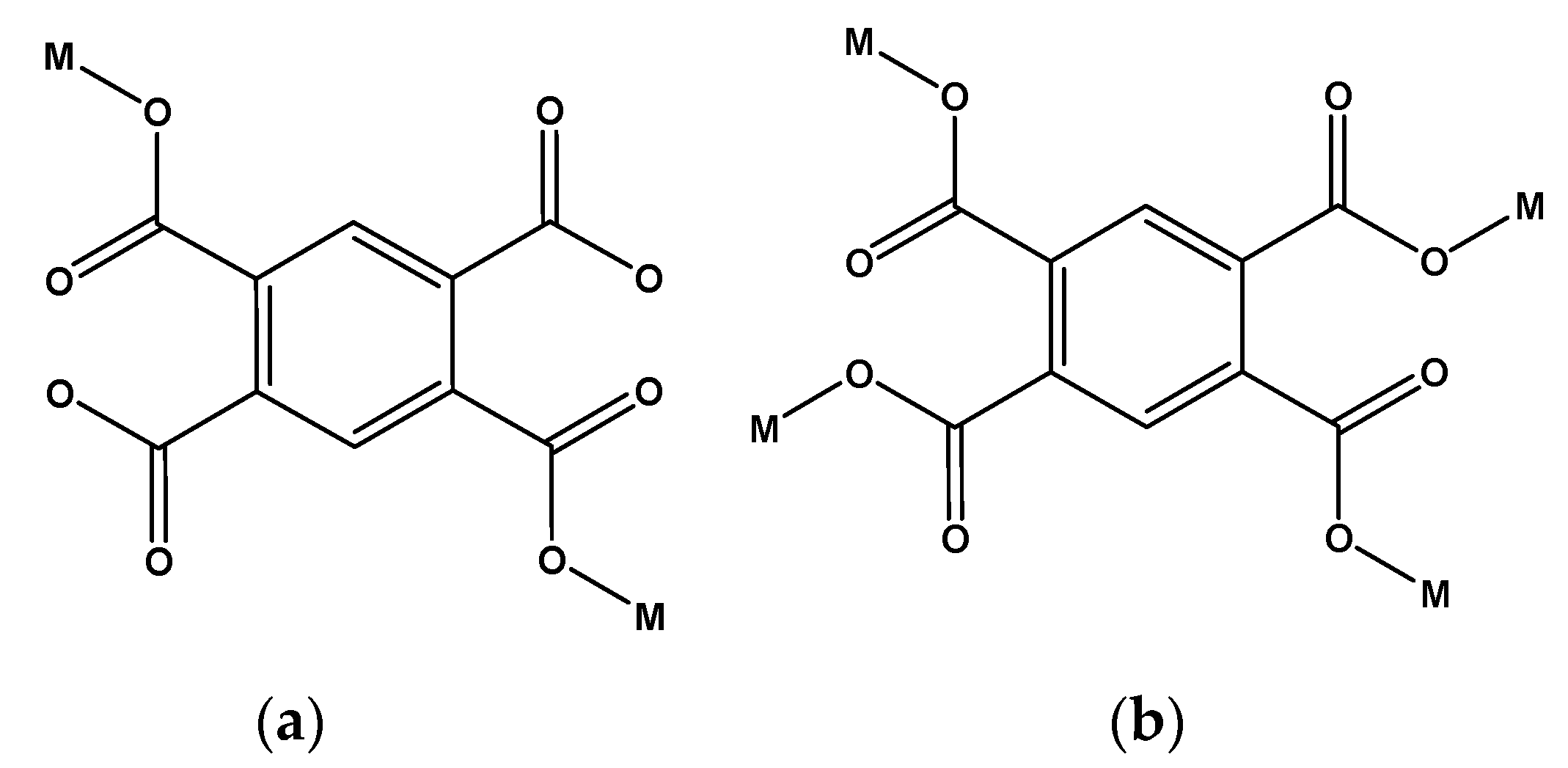
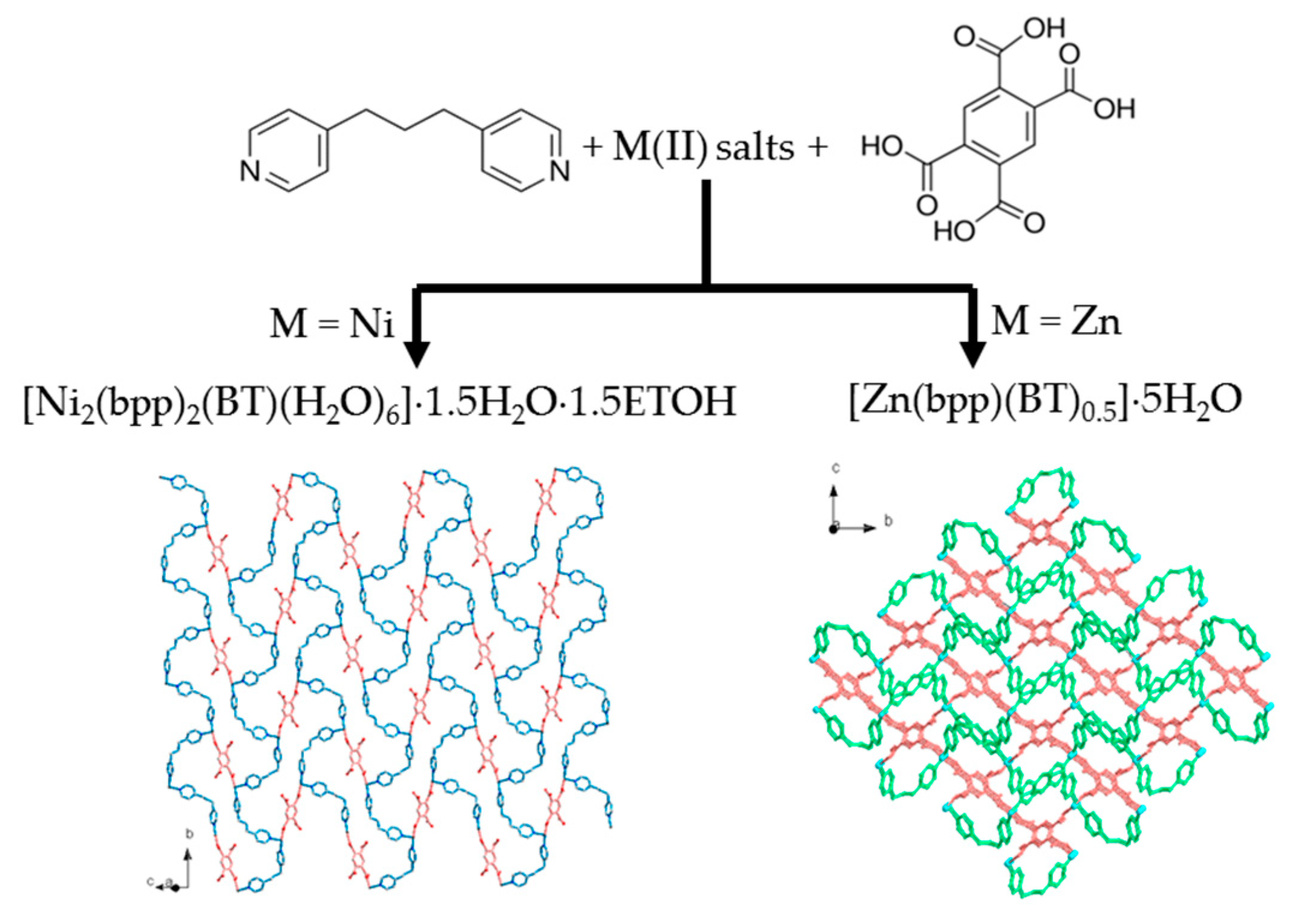
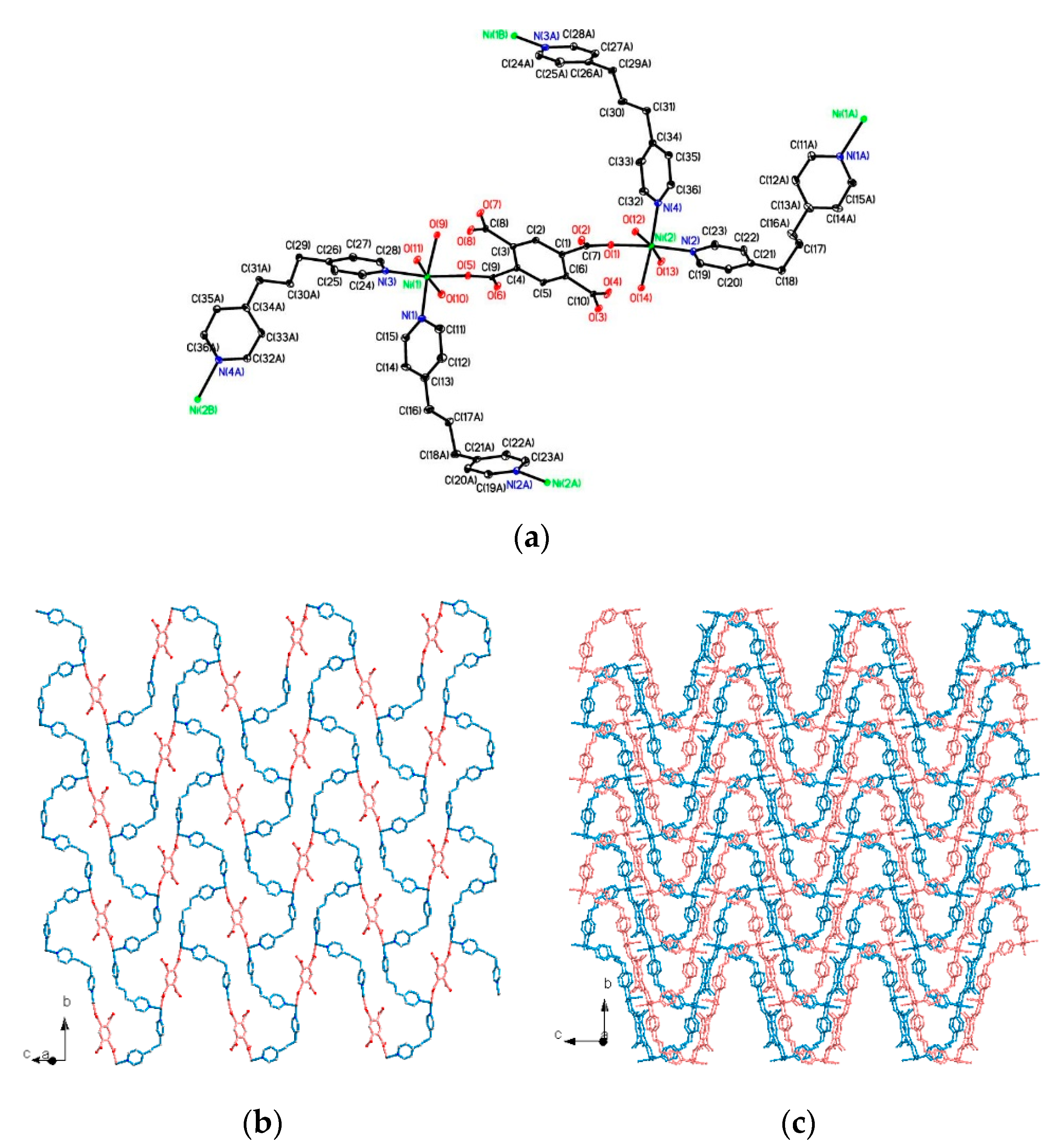
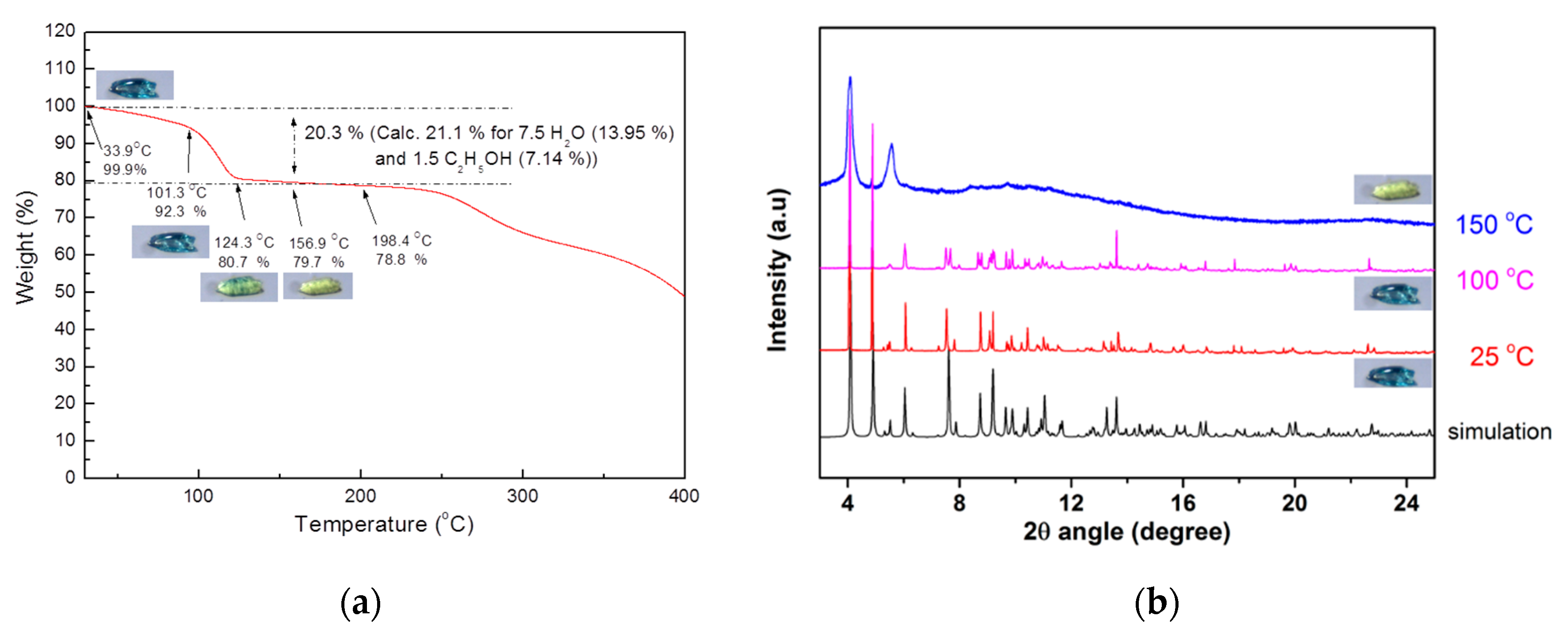
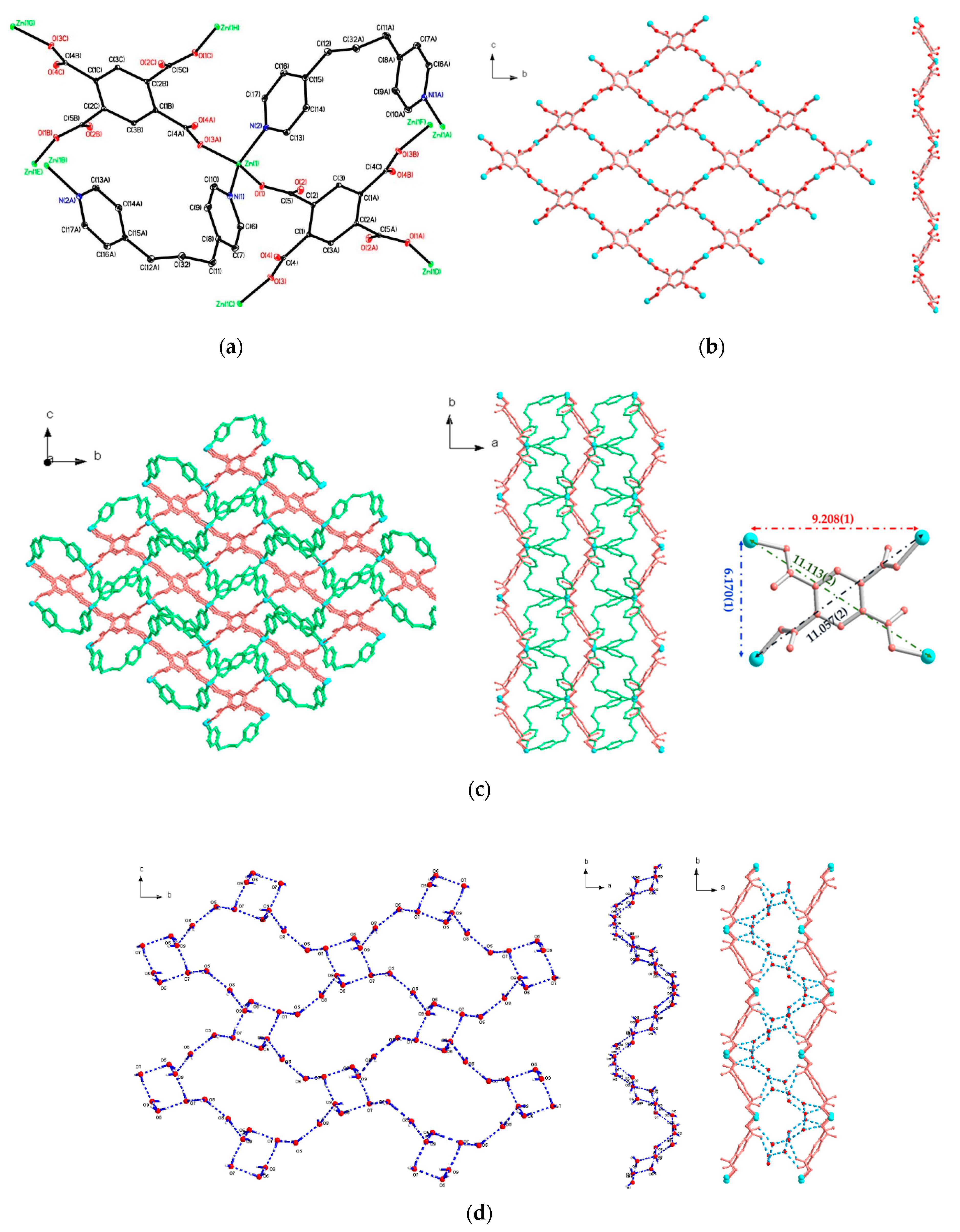
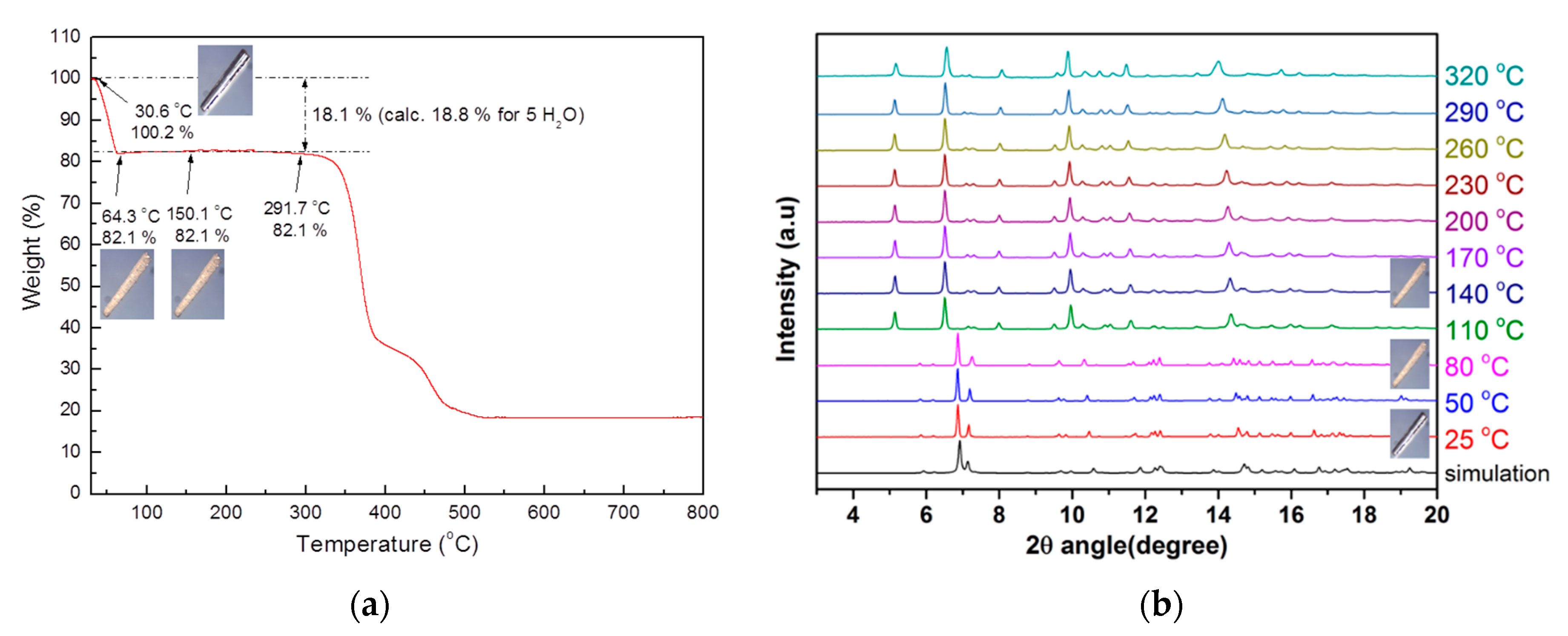
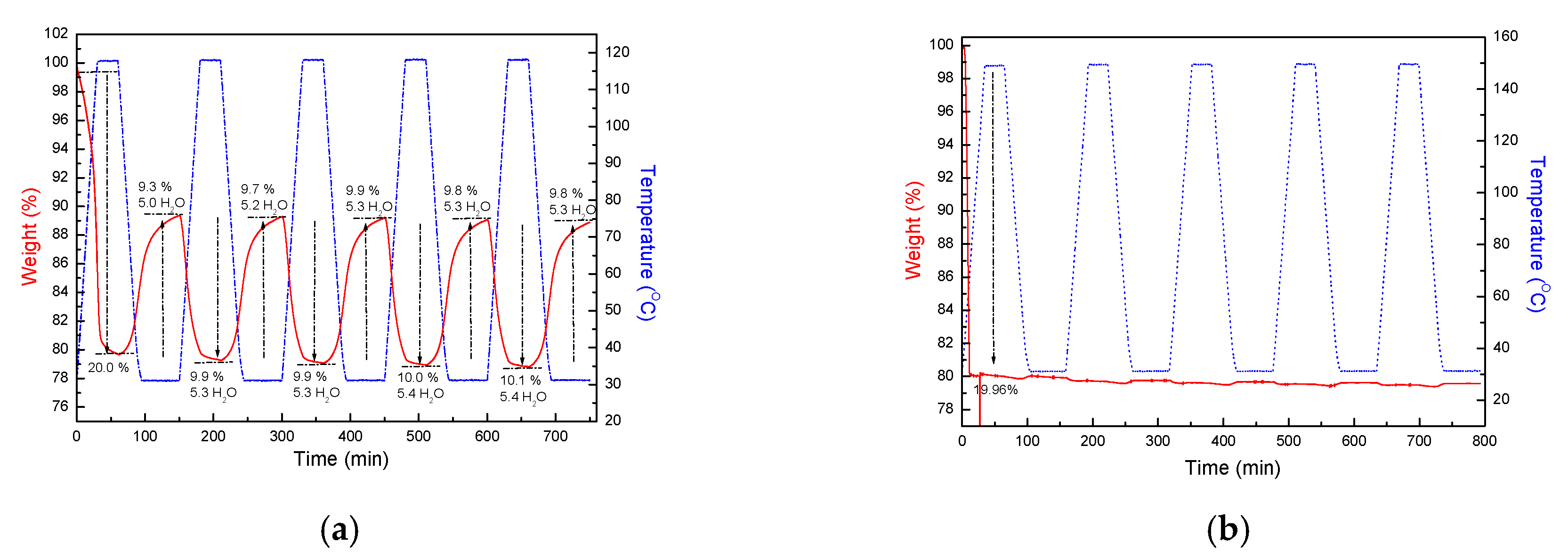
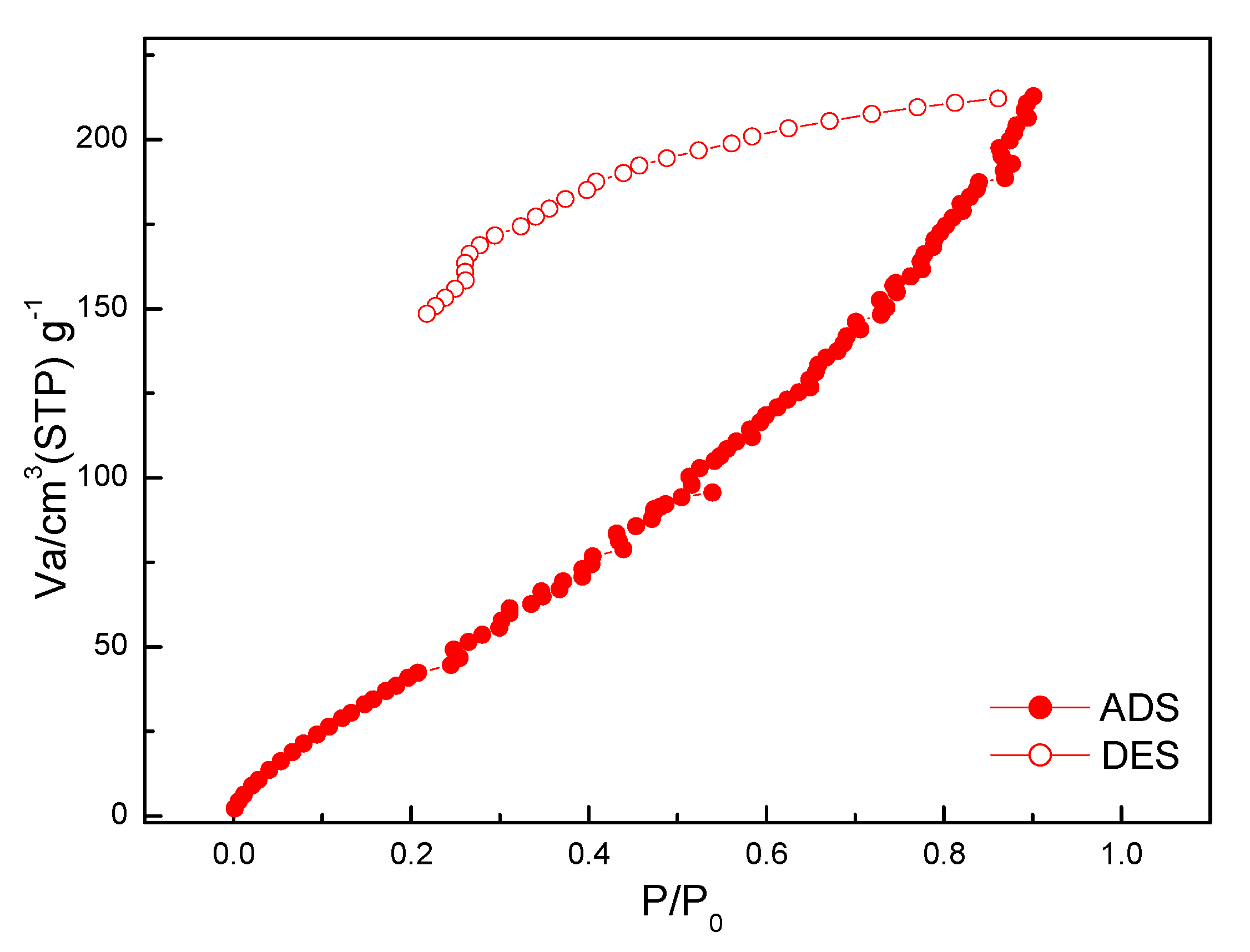
| 1 | 2 | |
|---|---|---|
| empirical formula | C39H54N4Ni2O17 | C18H25N2O9Zn |
| formula mass (g mol−1) | 968.28 | 478.77 |
| crystal system | Monoclinic | Monoclinic |
| space group | Cc | P 21/c |
| a (Å) | 9.9430(4) | 10.5868(5) |
| b (Å) | 19.3122(7) | 16.5965(7) |
| c (Å) | 23.3965(8) | 12.3099(5) |
| α (deg) | 90 | 90 |
| β (deg) | 98.8698(12) | 109.2795(13) |
| γ (deg) | 90 | 90 |
| V (Å3) | 4438.9(3) | 2041.60(15) |
| Z | 4 | 4 |
| T (K) | 150(2) | 150(2) |
| Dcalcd (g cm−3) | 1.449 | 1.558 |
| μ (mm−1) | 0.924 | 1.257 |
| θ range (deg) | 2.29–27.52 | 2.38–27.48 |
| total no. of collected data | 16656 | 17257 |
| no. of unique data | 9380 | 4684 |
| no. of obsd data (I > 2σ(I)) | 8689 | 4329 |
| Rint | 0.0181 | 0.0158 |
| refine params | 570 | 311 |
| R1, wR21 (I > 2σ(I)) | 0.0359, 0.0948 | 0.0217, 0.0550 |
| R1, wR21 (all data) | 0.0410, 0.0978 | 0.0247, 0.0564 |
| GOF 2 | 1.042 | 1.054 |
© 2020 by the authors. Licensee MDPI, Basel, Switzerland. This article is an open access article distributed under the terms and conditions of the Creative Commons Attribution (CC BY) license (http://creativecommons.org/licenses/by/4.0/).
Share and Cite
Wang, C.-C.; Yi, W.-C.; Huang, Z.-L.; Chang, T.-W.; Chien, W.-C.; Tseng, Y.-Y.; Chen, B.-H.; Chuang, Y.-C.; Lee, G.-H. Synthesis, Structures, and Water Adsorption of Two Coordination Polymers Constructed by M(II) (M = Ni (1) and Zn (2)) with 1,3-Bis(4-Pyridyl)Propane (bpp) and 1,2,4,5-Benzenetetracarboxylate (BT4−) Ligands. Polymers 2020, 12, 2222. https://doi.org/10.3390/polym12102222
Wang C-C, Yi W-C, Huang Z-L, Chang T-W, Chien W-C, Tseng Y-Y, Chen B-H, Chuang Y-C, Lee G-H. Synthesis, Structures, and Water Adsorption of Two Coordination Polymers Constructed by M(II) (M = Ni (1) and Zn (2)) with 1,3-Bis(4-Pyridyl)Propane (bpp) and 1,2,4,5-Benzenetetracarboxylate (BT4−) Ligands. Polymers. 2020; 12(10):2222. https://doi.org/10.3390/polym12102222
Chicago/Turabian StyleWang, Chih-Chieh, Wei-Cheng Yi, Zi-Ling Huang, Tsai-Wen Chang, Wen-Chi Chien, Yueh-Yi Tseng, Bo-Hao Chen, Yu-Chun Chuang, and Gene-Hsiang Lee. 2020. "Synthesis, Structures, and Water Adsorption of Two Coordination Polymers Constructed by M(II) (M = Ni (1) and Zn (2)) with 1,3-Bis(4-Pyridyl)Propane (bpp) and 1,2,4,5-Benzenetetracarboxylate (BT4−) Ligands" Polymers 12, no. 10: 2222. https://doi.org/10.3390/polym12102222
APA StyleWang, C.-C., Yi, W.-C., Huang, Z.-L., Chang, T.-W., Chien, W.-C., Tseng, Y.-Y., Chen, B.-H., Chuang, Y.-C., & Lee, G.-H. (2020). Synthesis, Structures, and Water Adsorption of Two Coordination Polymers Constructed by M(II) (M = Ni (1) and Zn (2)) with 1,3-Bis(4-Pyridyl)Propane (bpp) and 1,2,4,5-Benzenetetracarboxylate (BT4−) Ligands. Polymers, 12(10), 2222. https://doi.org/10.3390/polym12102222






